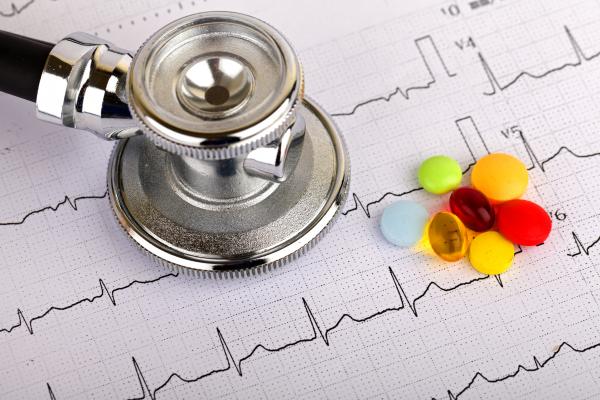Early rhythm control therapy improves outcomes in patients with atrial fibrillation
Patients with newly diagnosed atrial fibrillation (AF) benefit from early rhythm control therapy, according to results of EAST – AFNET 4, an AFNET/EHRA trial presented in a Hot Line session today at ESC Congress 2020[1,2]. Early rhythm control therapy with antiarrhythmic drugs and/or AF ablation reduced a composite of cardiovascular death, stroke, and hospitalization for worsening heart failure or acute coronary syndrome in 2789 patients with early AF and cardiovascular risk factors compared to usual care over a 5-year follow-up time.
Principal investigator Professor Paulus Kirchhof of the University Heart and Vascular Centre UKE Hamburg, Germany and the University of Birmingham, UK, states: “Rhythm control therapy initiated soon after diagnosis of atrial fibrillation reduced cardiovascular outcomes in patients with early AF and cardiovascular conditions without increasing time spent in hospital and without safety concerns. These results have the potential to completely change clinical practice towards rhythm control therapy early after the diagnosis of atrial fibrillation.”
According to guideline recommendations, rhythm control therapy is typically delayed unless patients have persistent symptoms on otherwise effective rate control. The EAST – AFNET 4 trial investigated whether rhythm control therapy – with antiarrhythmic drugs or ablation – delivered soon after AF diagnosis improves outcomes[3,4].
“Even on oral anticoagulation and optimal rate control, cardiovascular death, stroke, and heart failure are common in patients with atrial fibrillation, especially in those with concomitant cardiovascular conditions” said Professor John Camm, St. George’s University of London, UK, and EAST executive Steering Committee member.
“The risk of severe cardiovascular outcomes and death in patients with atrial fibrillation is highest in the first year after diagnosis, suggesting that early rhythm control therapy could be most beneficial,” Professor Kirchhof said. “Furthermore, atrial fibrillation causes atrial damage within a few weeks of disease onset. Early rhythm control therapy could reduce or prevent this damage, making it more effective.”
A total of 2789 patients with early AF (diagnosed less than a year ago) and at least two cardiovascular conditions (approximating a CHA₂DS₂-VASc score >=2) were enrolled by 135 sites in 11 countries during 2011 to 2016. Patients were randomised 1:1 to early rhythm control therapy or usual care, stratified by sites. Patients in both groups received guideline-recommended treatment for underlying cardiovascular conditions, anticoagulation, and rate control.
All patients in the early rhythm control group received antiarrhythmic drugs or catheter ablation after randomization (chosen by the local study teams). Rhythm control therapy was escalated with AF ablation and/or antiarrhythmic drugs when recurrent atrial fibrillation was documented clinically or by ECG, including monitoring with patient-operated ECG devices.
Patients in the usual care group were initially managed with rate control. Rhythm control therapy was only used to improve atrial fibrillation-related symptoms despite optimal rate control, following current guidelines.
The first primary outcome was a composite of cardiovascular death, stroke, or hospitalization with worsening heart failure, and acute coronary syndrome. The second primary outcome was nights spent in hospital per year. The primary safety outcome was a composite of stroke, all-cause death, and serious adverse events caused by rhythm control therapy.
Randomization occurred a median of 36 days after the first diagnosis of AF (‘early AF’). Almost all patients randomized to early rhythm control received the allocated therapy (95%), consisting of either one of the major antiarrhythmic drugs or AF ablation. At two years, 65% of patients randomized to early rhythm control were still on rhythm control therapy, and 19.4% of patients received AF ablation. Of patients randomized to usual care, 85% were managed without rhythm control therapy at 2 years. More patients randomized to early rhythm control (82% at 2 years) were in sinus rhythm than those randomized to usual care (61%).
Approximately every 5th event was prevented by early rhythm control therapy: During a median follow-up of 5.1 years, a first primary outcome event occurred in 249 patients on early therapy and in 316 patients receiving usual care. Adjusting for the group-sequential design of the trial, the first primary outcome occurred less often in patients on early rhythm control (hazard ratio [HR] 0.79; confidence interval [CI] 0.67–0.94; p=0.005). The absolute risk reduction with early rhythm control was 1.1% per year.
Professor Hein Heidbuchel, Antwerp University, Belgium, and President of the European Heart Rhythm Association (EHRA): “The clinical benefit of early rhythm control therapy is remarkably consistent across subgroups, including asymptomatic patients, patients in sinus rhythm at randomization, and those with and without heart failure.” All components of the primary outcome occurred numerically less often in patients randomised to early therapy, and cardiovascular death and stroke were significantly reduced compared to usual care.
Regarding the second primary outcome, there was no difference in nights spent in hospital between groups (early therapy 5.8±21.9 days/year; usual care 5.1±15.5 days/year; p=0.226).
The primary safety outcome did not differ between groups (early therapy 231 events; usual care 223 events). Complications of rhythm control therapy were more common in patients on early therapy, but occurred infrequently, in line with other recent rhythm control trials, while stroke and death were less frequent in patients randomized to early rhythm control, leading to a neutral safety outcome.
Professor Andreas Goette, St. Vincenz-Hospital Paderborn, Germany, and EAST sponsor representative concludes: “AFNET and EHRA conducted EAST – AFNET 4 throughout Europe as a large investigator-initiated trial on a European level. The success of this trial confirms that such trials are a powerful tool to change clinical practice.”
Press Contact
Angelika Leute, PhD
Phone: +49 202 2623395
a.leute@t-online.de
Follow us on Twitter @afnet_ev and hashtag #EASTtrial.
Funding: AFNET, BMBF, DZHK, EHRA, Deutsche Herzstiftung, Abbott, Sanofi.
Disclosures:
Further support came from the European Union (grant agreement No 633196 [CATCH ME] to PK and AFNET.
PK reports grants from DZHK / BMBF, Sanofi, Abbott, European Heart Rhythm Association / ESC, German Heart Foundation during the conduct of the study; PK has received research support from European Union (IMI 116074 [BigData@Heart]), British Heart Foundation (FS/13/43/30324; PG/17/30/32961; PG/20/22/35093; AA/18/2/34218), Leducq Foundation, Medical Research Council (UK), and German Centre for Heart Research, from several drug and device companies active in atrial fibrillation, and has received honoraria from several such companies, outside the submitted work. In addition, PK is listed as inventor on two patents held by University of Birmingham (Atrial Fibrillation Therapy WO 2015140571, Markers for Atrial Fibrillation WO 2016012783) issued.
References and notes
[1]Abstract title: Early treatment of Atrial fibrillation for Stroke prevention Trial.
[2]Kirchhof P, Camm AJ, Goette A, Brandes A, Eckardt L, Elvan A, Fetsch T, van Gelder IC, Haase D, Haegeli LM, Hamann F, Heidbüchel H, Hindricks G, Kautzner J, Kuck K-H, Mont L, Ng GA, Rekosz J, Schön N, Schotten U, Suling A, Taggeselle J, Themistoclakis S, Vettorazzi E, Vardas P, Wegscheider K, Willems S, Crijns HJGM, Breithardt G, for the EAST–AFNET 4 trial investigators. Early rhythm control therapy in patients with atrial fibrillation. New England Journal of Medicine. Epub 29 Aug 2020. doi: 10.1056/NEJMoa2019422
[3]The Early treatment of Atrial fibrillation for Stroke prevention Trial (EAST – AFNET 4). http://www.easttrial.org/
[4]Kirchhof P, Breithardt, Camm AJ, et al. Improving outcomes in patients with atrial fibrillation: rationale and design of the Early treatment of Atrial fibrillation for Stroke prevention Trial. Am Heart J. 2013;166:442-448. doi:10.1016/j.ahj.2013.05.015
About the Atrial Fibrillation NETwork (AFNET)
The Atrial Fibrillation NETwork is an interdisciplinary research network comprising scientists and physicians from hospitals and practices dedicated to improving the management of atrial fibrillation through coordinated research in Germany, Europe, and the USA. Its main objective is to conduct high quality investigator-initiated clinical trials and registries on a national and international level. The AFNET continues the long-term activities of the network which has been funded by the German Federal Ministry of Research and Education over a decade. Since January 2015, specific projects and infrastructures of the AFNET are funded by the German Centre for Cardiovascular Research (DZHK).
About the European Heart Rhythm Association (EHRA)
EHRA is one of the 7 associations of the European Society of Cardiology (ESC), which is a volunteer-led, not-for-profit, medical society. Today, the ESC encompasses 57 National Cardiac Societies, 46 Affiliated Cardiac Societies, 4000 fellows and 95000 Healthcare professionals. ESC and EHRA are the leading scientific cardiology and arrhythmology societies in Europe, organizing congresses and publishing many position and consensus documents that stimulate innovation and research. EHRA and ESC have already successfully participated in multiple EU-funded projects, many on AF, like CATCH-ME, PROFID, ESCAPE-NET, ASSERT-AF and BigData@Heart.



